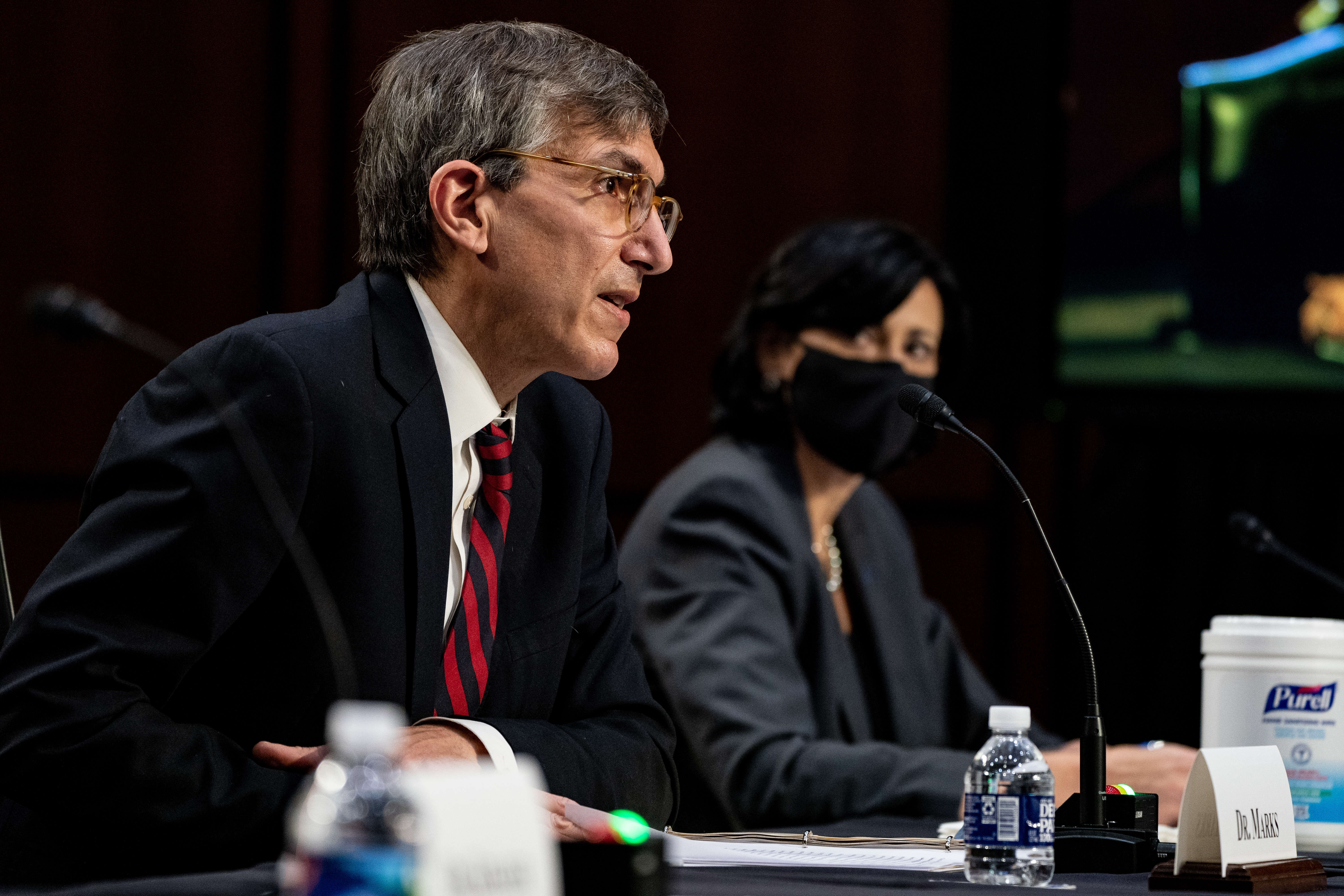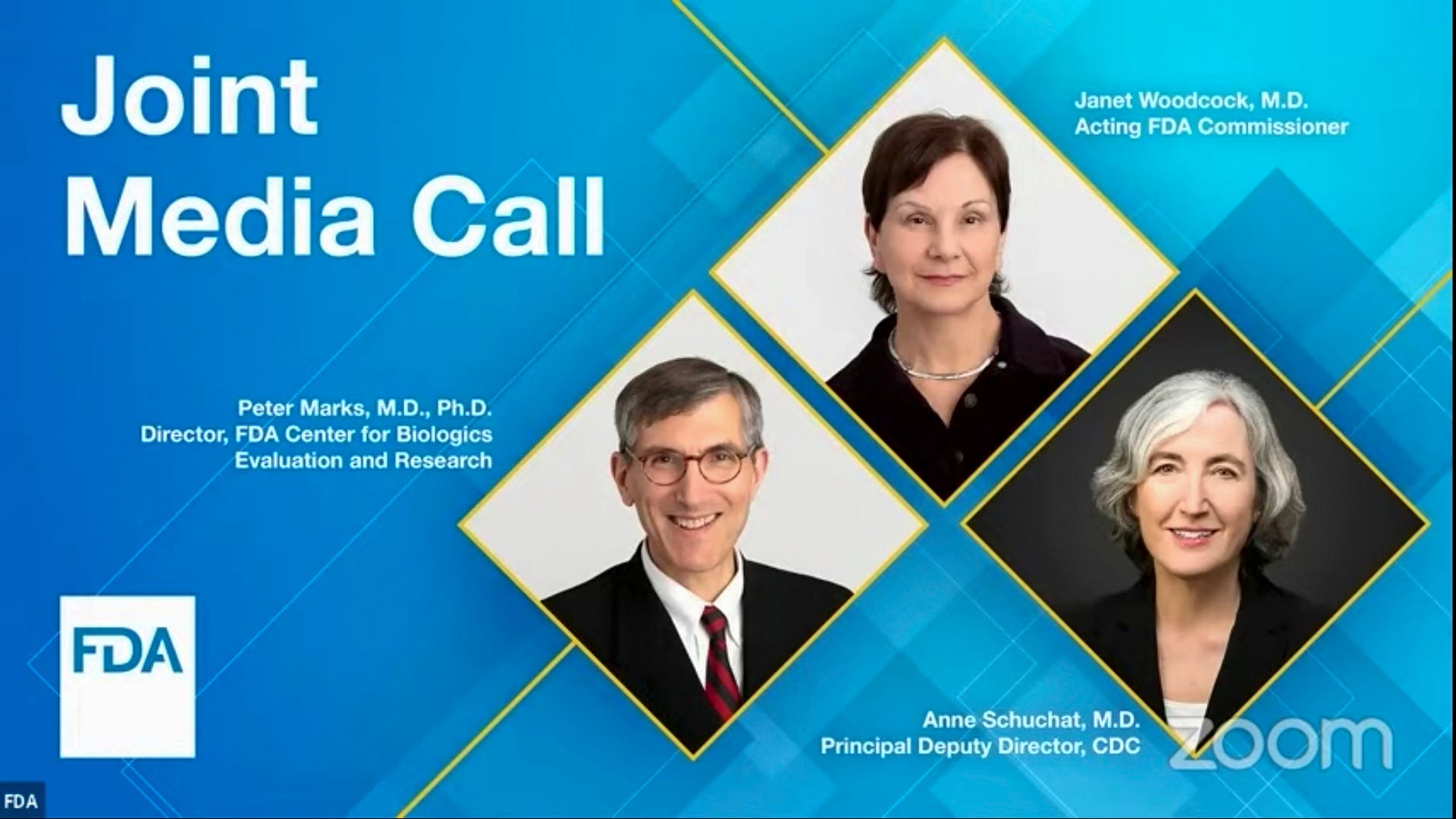Behind the historic US vaccine effort is FDA’s Peter Marks. The job is ‘not for the faint of heart.’

Earlier this month, Dr. Peter Marks helped make the decision to ditch 60 million doses of COVID-19 vaccine, worried they might have been manufactured under unsafe conditions.
In April, he was part of the group that ordered the pause on the Johnson & Johnson vaccine when it appeared the shots were causing a potentially fatal side effect.
And early last spring, he played a pivotal role in an all-out effort to quickly develop and mass produce hundreds of millions of doses of COVID-19 vaccine. To add urgency, he named the project after the incredibly fast rate a spaceship could travel on the cult classic TV series Star Trek: warp speed.
Marks, 57, who runs a division of the Food and Drug Administration, has played a key role in nearly every major vaccine-related decision since the United States’ COVID-19 outbreak began.
Dr. Peter Marks, Director of the Center for Biologics Evaluation and Research within the Food and Drug Administration, gives an opening statement during a Senate Health, Education, Labor and Pensions Committee hearing to discuss the ongoing federal response to COVID-19 on May 11, 2021 in Washington, DC. (Photo: Pool Photo by Greg Nash)
“The U.S. response to the pandemic as far as vaccines … was largely his concept,” said Dr. Janet Woodcock, acting FDA director and Marks’ boss.
It was his idea, she said, for the government to help vaccine companies quickly produce enough safe and effective vaccines for every American. “It was definitely Peter who put the idea together for Operation Warp Speed for vaccines.”
Dr. Stephen Hahn, who ran the FDA from 2019 through January, said one pharmaceutical executive told him Marks was “not a pushover,” providing clear direction and oversight to speed the process and help companies do their jobs better.
“It would have been easy for someone who was in a position of authority at an agency to stand back and use the procedures that had been used during normal times,” Hahn said.
But Marks didn’t do that.
“Peter was not afraid last year to do things that were necessary to foster innovation and bring novel things forward during a once-in-a-lifetime pandemic,” Hahn said.
The effort was in character for Marks, who spent years as a cancer specialist and then moved into industry and government to try to help more people.
Now, as head of the Center for Biologics Evaluation and Research (CBER), Marks is responsible for ensuring that products made from living sources are safe, effective and widely available. His division also oversees advances in gene therapy, one of the most cutting-edge areas of medicine.
Fyodor Urnov, a professor and gene editing expert at the University of California, Berkeley, said Marks truly understands the potential for gene editing to provide transformative treatments for everything from rare diseases to widespread killers like heart disease.
“His leading of CBER will be highlighted as one of the things that made the era of gene editing possible,” Urnov said.
Staying above the fray
Marks, who has an M.D. and a Ph.D. from New York University, is known for his strong intellect and character.
“His mind is working at warp speed,” Woodcock said. “Sometimes, it’s a little bit hard to keep up with where he’s going.”
Though appearing straight-laced and always professionally dressed without a hair out of place, Marks often gets a twinkle in his eye and fires off a quip. Meetings with him are punctuated with laughter, she said.
Woodcock described herself as the more pragmatic and concrete of the two: “He’s more the mad scientist with incredible ideas.”
Unlike some visionaries, Marks is persistent and follows through.
“Warp Speed got done. They’re moving ahead on gene therapy,” Woodcock said. “He has big ideas and doesn’t let go of them.”
Asked to describe himself, Marks praised his staff and played down his own role in recent events.
“I’m a pretty boring person who feels very lucky to work with a lot of tremendously talented people making sure we do the right thing by public health,” he said. “I’m very happy to be in the right place at the right moment to help be a part of that.”
Marks’ basement home office has become a familiar site to FDA-watchers. During repeated subcommittee meetings, he appeared on Zoom in front of paintings by his artist wife.
“For the first half of the year, I worked with the camera facing the ugly part of my basement and I was looking at these (paintings),” he said, describing the stuffed polar bear, teapot and pillow still lifes. Then he decided to turn his desk around to improve the public’s view.
Dr. Peter Marks, Director of the Center for Biologics Evaluation and Research within the Food and Drug Administration speaks during a hearing, with the Senate Committee on Health, Education, Labor, and Pensions, on the Covid-19 response, on Capitol Hill on March 18, 2021 in Washington, DC. Dr. Anthony Fauci appeared before a joint hearing of the house committees to lay out a timeline for vaccinating children against COVID-19. (Photo: Pool photo by Anna Moneymaker)
The FDA faced criticism last year for yielding to political influence, authorizing use of hydroxychloroquine and convalescent plasma, before either was proved a safe or effective treatment against COVID-19. But Marks’ division, which doesn’t handle drugs, was roundly praised for sticking to the science with vaccine development and staying above the fray.
Dr. Paul Offit, director of the Vaccine Education Center at Children’s Hospital of Philadelphia, said he got a call from Marks after Offit wrote an op-ed in The New York Times. The article expressed the concern of Offit and a colleague that vaccines would fall prey to politics before November’s election.
Marks told him: “If that happens, I’m going to quit and a lot of people will quit,” Offit said.
The “October surprise” Offit feared didn’t happen: “They did stand up to the political pressure.”
Tireless work by Marks and two other FDA officials, Marion Gruber and Dr. Doran Fink, were essential to getting the vaccines to the public, said Dr. Jesse Goodman, an infectious disease expert who chairs the COVID-19 Vaccine Analysis Team and is a professor at Georgetown University.
“I don’t think this could have happened without the FDA,” he said.
Right place, right moment
Marks was on a train heading to New York City when he first realized his life would be transformed by COVID-19.
It was late February 2020 and he was preparing to give a talk in his hometown. Somewhere between Philadelphia and Trenton, New Jersey, he saw data showing COVID-19 already was infecting people on five continents.
“Even though the case number was not incredibly high, once you had something that dispersed, there was no way you could imagine you were going to have containment as the strategy,” he said. “When you can’t contain, you mitigate.”
He recognized that speed was essential for saving lives.
“Every day you get a vaccine to someone faster, it means something,” he said.
Marks looked to Star Trek for the vaccine project’s name, not, he insists, because he’s a committed Trekkie, but because, “the name was meant to shake us out of our everyday mode of doing things.”
One of the ideas for speeding the process was to manufacture “at risk” – to start making product even before it had been proven safe and effective. If the vaccine failed to meet the same standards as other vaccines, all that product would have to be thrown out. But when one trial and then another proved out, there were millions of doses nearly ready to be injected into arms.
He expected problems. Any shot delivered to millions of people will cause some harm. “Watching vaccines is not for the faint of heart,” said Marks, who was part of the small group that decided to pause use of the Johnson & Johnson vaccine for 10 days in April so a rare side effect could be better understood and the public informed.
“I think allowing people the choice to know what is going on is very reasonable,” he said.
Marks understands why some might be hesitant about getting vaccinated, but as with most things, he assumes more knowledge is the solution.
“I’d like to believe if we can answer enough people’s questions about vaccines that we would eventually get them to come on their own to realize this is not such a bad idea,” said Marks, who speaks to two or three groups a week trying to counter hesitancy. “In general, it’s a matter of making sure that people don’t feel judged about their questions.”
This image accompanied the audio-only media call with the Food and Drug Administration after the Centers for Disease Control and Prevention and the FDA said Tuesday, April 13, 2021, it was investigating clots and reduced platelet counts in six women, days after receiving the Johnson & Johnson COVID-19 vaccine. On the call are Dr. Peter Marks, director of the Food and Drug Administration Center for Biologics Evaluation and Research, acting Food and Drug Administration commissioner Dr. Janet Woodcock and deputy director of the Centers for Disease Control and Prevention Dr. Anne Schuchat. Even before the coronavirus surfaced, training guides by the Centers for Disease Control and Prevention noted the difficulty of communicating in a public health crisis, when fear and uncertainty are running high. Yet how leaders communicate can be key to winning public cooperation. Or undermining it. (Photo: FDA via AP)
He shuddered remembering how “excruciatingly painful” it was to be patient while being grilled by a group of extremely vaccine hesitant Hasidic Jews. But he kept his cool. Afterward, he said, “that was the closest to ever getting fan mail I’ve ever had.”
Marks said he’s grateful that his involvement in vaccine development has not led to celebrity. He doesn’t want to be the subject of a bobble-head doll, like his colleague, the infectious disease expert Dr. Anthony Fauci: “I’ll stick to anonymity if I can.”
Marks said he’s found his people at the FDA, where he and his colleagues can concentrate on public health “to the exclusion of all the other noise,” such as profit motive, politics and pettiness. “Focusing on science-based public health – for the idealist in me – makes me very happy.”
It’s that idealism that has gotten him and his colleagues through the grueling last year-plus, he said: “It’s having a culture of people that don’t tire at the end of the day in quite the same way because they know that what they’re doing is critical for public health.”
While the rest of America is getting back to normal, Marks isn’t ready yet to move on from the pandemic. He thinks it’ll be with the world for a while, and may even surge again in the United States, particularly if people refuse vaccinations and masks.
And there are still many lessons to be learned to prepare for the next pandemic and to get better, cheaper treatments in the meantime.
“That transformation that we might do for pandemic preparedness,” he said, “could also potentially transform medicines for our day-to-day life.”
Contact Karen Weintraub at [email protected].
Health and patient safety coverage at USA TODAY is made possible in part by a grant from the Masimo Foundation for Ethics, Innovation and Competition in Healthcare. The Masimo Foundation does not provide editorial input
Source: Read Full Article



